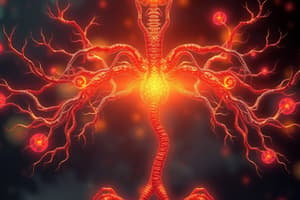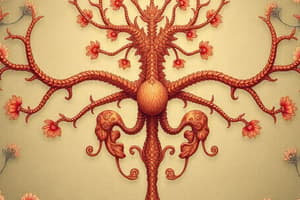Podcast
Questions and Answers
Which of the following hormones is secreted by the parathyroid glands?
Which of the following hormones is secreted by the parathyroid glands?
- Epinephrine
- Thymosin
- Insulin
- Parathyroid hormone (correct)
The thymus gland shrinks with age.
The thymus gland shrinks with age.
True (A)
Which hormone is secreted by the adrenal medulla?
Which hormone is secreted by the adrenal medulla?
- Aldosterone
- Insulin
- Cortisol
- Epinephrine (correct)
What is the primary function of aldosterone?
What is the primary function of aldosterone?
Which hormone is responsible for breaking down fat stores and releasing sugar back into the blood?
Which hormone is responsible for breaking down fat stores and releasing sugar back into the blood?
Insulin is secreted by the pancreas and helps store sugar as fat.
Insulin is secreted by the pancreas and helps store sugar as fat.
What are the two main hormones secreted by the ovaries?
What are the two main hormones secreted by the ovaries?
Which of the following is NOT a class of hormones?
Which of the following is NOT a class of hormones?
Most hormones are peptides, meaning they are short chains of amino acids.
Most hormones are peptides, meaning they are short chains of amino acids.
Which of the following hormones is NOT derived from tyrosine?
Which of the following hormones is NOT derived from tyrosine?
What are eicosanoids produced from?
What are eicosanoids produced from?
Which of the following is NOT a characteristic of steroid hormones?
Which of the following is NOT a characteristic of steroid hormones?
The ______ mechanism of action is commonly used by peptide hormones due to their inability to cross the cell membrane.
The ______ mechanism of action is commonly used by peptide hormones due to their inability to cross the cell membrane.
What are the four small glands embedded in the thyroid gland?
What are the four small glands embedded in the thyroid gland?
What hormone does the parathyroid gland secrete?
What hormone does the parathyroid gland secrete?
Where is the thymus gland located?
Where is the thymus gland located?
What hormone does the thymus gland secrete?
What hormone does the thymus gland secrete?
The thymus gland grows larger with age.
The thymus gland grows larger with age.
Where are the adrenal glands located?
Where are the adrenal glands located?
What two hormones does the adrenal medulla secrete?
What two hormones does the adrenal medulla secrete?
What hormone does the adrenal cortex secrete that regulates reabsorption of nutrients from the kidney?
What hormone does the adrenal cortex secrete that regulates reabsorption of nutrients from the kidney?
What hormone does the adrenal cortex secrete that controls the rate of metabolism of carbohydrates, fats, and proteins?
What hormone does the adrenal cortex secrete that controls the rate of metabolism of carbohydrates, fats, and proteins?
Where is the pancreas located?
Where is the pancreas located?
What hormone does the pancreas secrete that tells the liver and muscles to remove sugar from the blood and store it as fat?
What hormone does the pancreas secrete that tells the liver and muscles to remove sugar from the blood and store it as fat?
What hormone does the pancreas secrete that tells the liver to break down fat stores and release sugar back into the blood?
What hormone does the pancreas secrete that tells the liver to break down fat stores and release sugar back into the blood?
What two hormones do the ovaries secrete?
What two hormones do the ovaries secrete?
What hormone does the endometrium in the uterus secrete when a fertilized egg binds to it?
What hormone does the endometrium in the uterus secrete when a fertilized egg binds to it?
Amine hormones are derived from tyrosine.
Amine hormones are derived from tyrosine.
Which of the following is a type of eicosanoid hormone?
Which of the following is a type of eicosanoid hormone?
Steroid hormones are hydrophilic.
Steroid hormones are hydrophilic.
What type of receptors do steroid hormones bind to?
What type of receptors do steroid hormones bind to?
What is the primary function of steroid hormones?
What is the primary function of steroid hormones?
Give an example of a steroid hormone.
Give an example of a steroid hormone.
Flashcards
Parathyroid glands
Parathyroid glands
These four small glands are embedded within the thyroid gland and regulate calcium levels in the blood and bone absorption.
Thymus gland
Thymus gland
Located below the thyroid, between the lungs, the thymus secretes thymosin, stimulating T-cell production in children.
Parathyroid hormone
Parathyroid hormone
Secreted by the parathyroid glands, this hormone controls calcium levels in the blood and bones.
Thymosin
Thymosin
Signup and view all the flashcards
Adrenal glands
Adrenal glands
Signup and view all the flashcards
Adrenal medulla
Adrenal medulla
Signup and view all the flashcards
Adrenal cortex
Adrenal cortex
Signup and view all the flashcards
Cortisol
Cortisol
Signup and view all the flashcards
Pancreas
Pancreas
Signup and view all the flashcards
Insulin
Insulin
Signup and view all the flashcards
Glucagon
Glucagon
Signup and view all the flashcards
Ovaries
Ovaries
Signup and view all the flashcards
Estrogen
Estrogen
Signup and view all the flashcards
Progesterone
Progesterone
Signup and view all the flashcards
Endometrium
Endometrium
Signup and view all the flashcards
Peptides
Peptides
Signup and view all the flashcards
Amines
Amines
Signup and view all the flashcards
Steroids
Steroids
Signup and view all the flashcards
Eicosanoids
Eicosanoids
Signup and view all the flashcards
Hydrophilic hormones
Hydrophilic hormones
Signup and view all the flashcards
Hydrophobic hormones
Hydrophobic hormones
Signup and view all the flashcards
Second messenger mechanism
Second messenger mechanism
Signup and view all the flashcards
Steroid hormones
Steroid hormones
Signup and view all the flashcards
Insulin
Insulin
Signup and view all the flashcards
Glucagon
Glucagon
Signup and view all the flashcards
Sex hormones
Sex hormones
Signup and view all the flashcards
Endometrium
Endometrium
Signup and view all the flashcards
Epinephrine (adrenaline)
Epinephrine (adrenaline)
Signup and view all the flashcards
Norepinephrine
Norepinephrine
Signup and view all the flashcards
Aldosterone
Aldosterone
Signup and view all the flashcards
Study Notes
Parathyroid Gland
- Embedded in the thyroid gland
- Secretes parathyroid hormone, regulating blood calcium levels and bone absorption.
- Four small glands
Thymus Gland
- Located below the thyroid, between the right and left lung
- Secretes thymosin, stimulating T-cell (a type of white blood cell) production in children
- Shrinks with age as antibody stores develop.
- Exposure to more germs builds antibody stores.
Adrenal Glands
- Two glands located on top of the kidneys
- Medulla secretes epinephrine (adrenaline) and norepinephrine, regulating the "fight or flight" response during stress
- Cortex secretes aldosterone, regulating nutrient reabsorption from the kidneys
- Cortex also secretes cortisol, controlling carbohydrate, fat, and protein metabolism.
Pancreas
- Located behind the right side of the stomach
- Secretes insulin, instructing the liver and muscles to remove sugar from the blood and store it as fat
- Also secretes glucagon, instructing the liver to break down fat stores and release sugar into the blood.
Ovaries
- Secrete estrogen and progesterone, regulating the female menstrual cycle
- The endometrium in the uterus also secretes a female hormone when a fertilized egg binds, stopping the cycle from progressing to menstruation.
Classes of Hormones
- Peptides: Short chains of amino acids (most hormones); produced by: pituitary, parathyroid, heart, stomach, liver, kidneys; hydrophilic, large, bind surface receptors.
- Amines: Derived from tyrosine; secreted by thyroid and adrenal cortex; hydrophilic; synthesized from a single amino acid (e.g., melatonin from tryptophan, thyroid hormone from tyrosine, catecholamines (EPI, DA) from tyrosine).
- Steroids: Lipids derived from cholesterol; secreted by gonads, adrenal cortex, and placenta; hydrophobic/lipophilic, small, travel in the blood with carriers, bind to cytoplasmic or nuclear receptors (e.g., estradiol).
- Eicosanoids: Produced from 20-carbon fatty acid (arachidonic acid); produced in all cells except red blood cells; includes prostaglandins and leukotrienes; involved in inflammation.
- Peptide/Protein Hormones
- Hydrophilic
- Large
- Cannot fit through cell membranes
- Use second messenger mechanisms
- Most common hormone type
- Translated, packaged, and sent.
- Bind surface receptors at target cells, mediating signal transduction/second messenger systems.
- Example: Insulin
- Amine Hormones
- Synthesized from a single amino acid.
- Eicosanoid Hormones
- Produced from 20-carbon fatty acid (arachidonic acid)
- Produced in all cells except red blood cells
- Use second messenger pathways
- Examples: Prostaglandins and leukotrienes.
- Involved in inflammation
- Steroid Hormones
- Small
- Hydrophobic/Lipophilic
- Travel in blood with carriers
- Bind to cytoplasmic or nuclear receptors
- Change protein synthesis
- Example: Estradiol
- Peptide/Protein Hormones
Studying That Suits You
Use AI to generate personalized quizzes and flashcards to suit your learning preferences.




